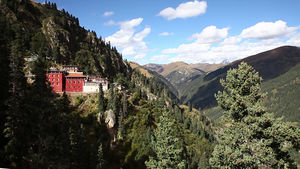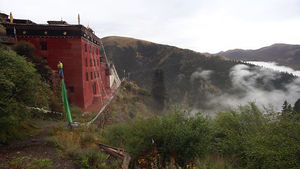Tsadra Rinchen Drak
The "Tsari-like Jewel Rock", hermitage and main seat of Jamgön Kongtrul Lodrö Thaye (1813-1899), above the Palpung monastery of the Tai Situ Rinpoches, established in 1858. It is a site sacred to Yangdag Heruka and Vajrakila, and was formally opened by Kongtrul together with the treasure revealer Terchen Chokgyur Lingpa (1829-1870) in 1857. It had previously been used as a retreat place by the 8th Tai Situpa (1700-1774), but had been abandoned and eventually fallen into disrepair. The terma cycle of "Sangthig Khorsum", containing practices on Yangdag, Vajrasattva and Vajrakila, was revealed here by Chokgyur Lingpa, along with the guide-book to the sacred site. It is here where Jamgon Kongtrul eventually established a three-year retreat center for the practices and teachings of the Shangpa Kagyu tradition and where he spent most of his life. All around the mountain, many sacred sites, self-arisen designs and syllables, as well as foot- and hand-prints of masters of the past, such as Guru Padmasambhava and Yeshe Tsogyal can be found. When the previous Kalu Rinpoche (1905-1989) eventually took over from his teacher, Lama Norbu Döndrub (1880-1954), and became the retreat master at Tsadra, he strongly wished to renovate and enlarge the place, thus making room for more retreatants. Already Jamgon Kongtrul, the 11th Tai Situpa Pema Wangchog Gyalpo (1886-1952) and also Lama Norbu Döndrub himself had such plans but had always postponed the project. The presence of large boulders and other problems seemed to make it very difficult indeed. Kalu Rinpoche boldly approached Situ Rinpoche and told him he could manage if Situ Rinpoche would only provide the necessary funding. Even though the Situpa expressed his doubts, Kalu Rinpoche kept saying that he could do it. Faced with such persistence, Situ Rinpoche and his advisers finally agreed to provide the funds and have Kalu Rinpoche go ahead with the project. Work started and now it was the laborers who were grumbling about how it could not be done. But strangely enough, they soon discovered that they seemed to have some mysterious, unseen helpers. They began to notice footprints of enormous size on the ground, which seemed to be from four individuals. But no one ever saw them. Kalu Rinpoche alone knew what was afoot. He had had a dream in which four tall and powerful men had appeared to him, bearing all sorts of tools and construction materials. Kalu Rinpoche asked them where they had come from and they replied that they came for a place called "Accomplishment of Wishes." They continued to say that they had heard of the difficult task he was about to begin and that they volunteered to help. When asked their names, they introduced themselves as Kshetrapala, Dzinamitra, Takkiraja and Trakshe. They were none other but the four attendants of the Six-armed Mahakala, the main protector of the Shangpa lineage. The red temple in the foreground has recently again been enlarged considerably. Technically, it is actually the cliff behind the retreat center that is referred to as Tsadra Rinchen Drak, while the center itself is named Kunsang Dechen Osal Ling. On this cliff, several caves are to be found, most notably the practice caves of Namkhai Nyingpo and the Indian master Mriti Jnana. Tsadra Rinchen Drak counts as one of the twenty-five sacred sites of the eastern Tibetan province of Kham.
The above pictures are screen-shots of a video that was recently sent to me. Unfortunately the photographer is not known to me, so I can't give proper credit at the present moment. [TSD]


